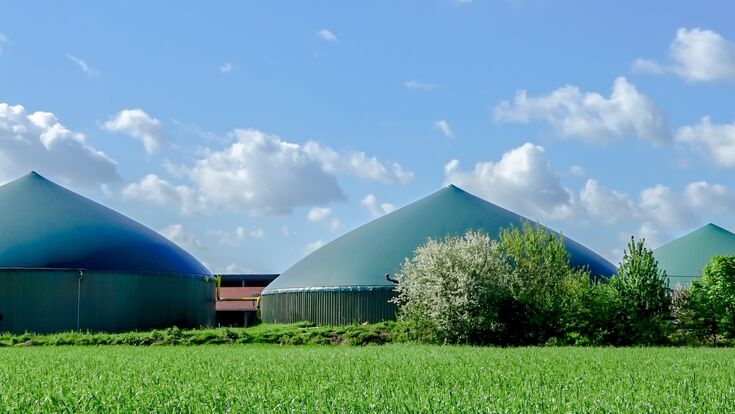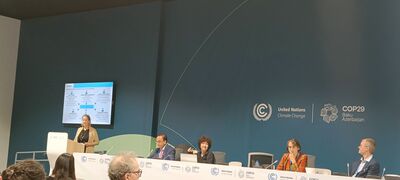Biogas and Biomethane : The challenges of financing methane mitigation in waste management

The urgency of addressing methane emissions has never been clearer. Methane, a potent greenhouse gas, accounts for approximately 30% of global warming since the pre-industrial era, and the waste sector contributes significantly to its release. Biogas and biomethane offer a sustainable alternative to natural gas, with the potential to mitigate methane emissions while generating renewable energy. Yet, despite the promise of anaerobic digestion (AD) technology, financing such projects remains a major challenge. These issues took centre stage at a COP29 side event hosted by the World Biogas Association (WBA) and the International Solid Waste Association (ISWA). The discussion highlighted the barriers, opportunities and policy interventions needed to unlock the potential of biogas and biomethane in tackling methane emissions globally.
Related article: News from Baku: It’s all about the money
The case for biogas and biomethane
Biogas is produced through anaerobic digestion, a process where organic waste is broken down in the absence of oxygen, yielding biogas (a mix of methane and carbon dioxide) and digestate (a nutrient-rich byproduct). Upgraded biogas, or biomethane, can replace natural gas in heating, electricity generation and transport. Beyond energy generation, anaerobic digestion delivers additional environmental benefits, including reducing methane emissions from decomposing organic waste in landfills and offering a sustainable alternative to synthetic fertilisers through the use of digestate
Globally, organic waste accounts for over 50% of total waste in most regions, yet 2.7 billion people lack access to formal waste collection. Capturing and processing this waste through anaerobic digestion could have a transformative impact. According to the WBA, capturing just 50% of food waste could abate 20 million tonnes of methane annually.
Related article: Biomethane: The solution for Europe's energy independence?
Financing gaps and challenges
Despite its potential, biogas technology faces significant financing barriers, as highlighted by Charlotte Morton, Chief Executive of the WBA. Green industries like biogas are at a disadvantage due to the heavy subsidies given to fossil fuel industries ‒ estimated by the International Monetary Fund (IMF) at $7 trillion annually. This creates a lack of a level playing field, making it difficult for renewable energy projects to compete. In contrast to solar or wind projects, biogas initiatives are perceived as riskier investments due to the complexities of waste management and multi-source revenue generation.
Anja Schwetje from ISWA underscored the challenges of mobilising capital for biogas projects, particularly smaller-scale initiatives. The waste sector often lacks the financial incentives needed to make methane mitigation projects attractive to investors. The current market conditions favour cheap disposal methods like landfill dumping, which fail to account for the environmental and societal costs of methane emissions. Meanwhile, biogas projects must navigate a complex financial landscape involving multiple revenue streams ‒ from energy sales to the production of organic fertilisers.
Related article: Biomethane: On the road away from fossil fuels

The role of policy and NDCs
Nationally Determined Contributions (NDCs) under the Paris Agreement are critical tools for integrating waste management and methane reduction into national climate strategies. However, as Martina Otto from the Climate and Clean Air Coalition (CCAC) emphasised, waste management often remains a low priority in NDCs, despite its significant mitigation potential. Ambitious targets and clear investment plans within NDCs are essential to drive action.
The Global Methane Pledge ‒ for which the CACC provides secretariat services ‒ supported by over 180 partners, aims to catalyse action on methane mitigation. Otto highlighted the importance of respecting the waste hierarchy ‒ from waste prevention to recycling and composting—to maximise the climate benefits of waste management. She also pointed out that while there are business opportunities in every aspect of the waste hierarchy, the majority of investments currently flow into incineration rather than methane-reducing practices.
Related article: Putting Waste on the COP29 Agenda
Bridging the financing gap
To scale up biogas and biomethane projects, innovative financing mechanisms are needed. Recommendations from the WBA and ISWA include:
- Incorporating Methane Abatement into Emissions Trading Schemes (ETS): Methane-related emissions from waste should be valorised within existing ETS, with a view towards interoperability in global carbon markets. Setting floor prices for methane abatement credits could provide additional financial incentives.
- Supporting High-Ranking Activities in the Waste Hierarchy: Investments should prioritise prevention, recycling and composting over less sustainable practices like incineration and landfilling.
- Rethinking Financial Models: Biogas projects often require blended finance approaches, combining public funding, private investment and carbon market revenues. Clear funding criteria and the inclusion of biogas in sustainable finance taxonomies, as seen in the EU, could help direct resources towards these projects.
- Introducing the Polluter Pays Principle: Ensuring that industries causing environmental harm bear the cost of their actions could help create a level playing field for biogas and biomethane.
The European Union as a case study
The EU’s approach to biowaste management demonstrates both the challenges and opportunities in financing sustainable waste practices. According to Janek Vähk from Zero Waste Europe, the EU generates 60 million tonnes of kitchen waste annually, yet only 15% is captured for treatment. Biowaste collection remains more expensive than residual waste collection, presenting economic barriers.
The EU Emissions Trading System (ETS) and Taxonomy for Sustainable Finance offer frameworks for directing investments towards environmentally beneficial projects. Anaerobic digestion and composting are recognised as sustainable waste management activities under the Taxonomy, encouraging a shift in investment focus. However, controversies remain, such as the exclusion of municipal solid waste (MSW) incineration from the ETS, which some argue could enhance sorting and recycling efforts.
Related article: ISWA’s interventions in the Blue Zone at COP29
Unlocking the potential of biogas and biomethane
The benefits of biogas and biomethane extend beyond methane mitigation. These technologies can drive economic development, create jobs and enhance energy security while addressing pressing waste management challenges. However, structural challenges, including the lack of financial incentives, regulatory support and public awareness, continue to hinder their adoption.
To unlock their full potential, a concerted effort is needed to elevate waste management on the global climate agenda, as emphasized by Schwetje and Morton. This includes ambitious NDCs that integrate methane mitigation from organic waste, targeted investments in high-ranking waste hierarchy activities and the creation of market conditions that reward sustainable practices.
Conclusion
As the COP29 Reducing Methane from Organic Waste Declaration gains momentum following its high-level launch in Baku, it is imperative to recognise the transformative role of biogas and biomethane in achieving the 1.5°C climate target. This declaration underscores the urgency of tackling methane emissions from organic waste and provides a roadmap for integrating waste management into national climate strategies.
By addressing the financing gap, leveraging policy tools like ETS and sustainable finance taxonomies, integrating waste management into national climate strategies and prioritising high-ranking activities in the waste hierarchy, the waste sector can shift from being a major emitter of methane to a vital contributor to global climate solutions, the panellists agreed.
As Charlotte Morton aptly put it, living in a world where industries that harm the planet are subsidised while green solutions struggle to compete is unsustainable. It is time for governments, investors and society at large to rethink how we value waste ‒ and act accordingly.


